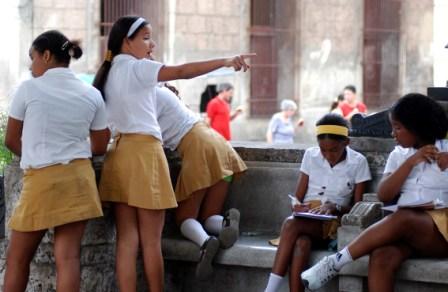Formal education (I)
By Regina Cano

I visited a particularly memorable art exhibit during the last Havana Biennial. This showing was not set up at one of the official (State) sites of the Biennial; instead, it was located at the Fanguito-Studio, in the Vedado neighborhood, home of artist Rodolfo Peraza.
There, the artist presented a work called “Play and Learn,” in which the cornerstone of his work was the Cuban textbook “The Manual of Formal Education.” The book advises, for example, that couples should not demonstrate affection in public, and that the police must always be obeyed.
That treatise served as the basis for a video game in which the player has a gun that they use to shoot at a text taken from “The Manual.” If the player doesn’t shoot (as is the accepted norm), the text remains still; on the other hand, if you open fire, the letter “o” becomes a machinegun nest. Like any other combat game, this has several levels, each increasingly difficult.
Throughout the course of the game, if you are a capable commando – and lucky – through its various levels you can even an old score, another way of saying that you can take revenge on an old and painful memory.
The expression “Formal Education” brings to my mind a concept that was stated and re-stated during my adolescence and young adulthood. Schools and the mass media communicated it, mass organizations and political groups monitored it, and the people – of course – reflected it.
This persistent repetition caused my generation to reject that notion – since the more it was mentioned, the more unpleasant “Formal Education” became. It had the image of being something that was mandatory but which lacked explanations or rationale. This created a certain feeling of emptiness in the reasoning of us as children and adolescents, which produced the opposite of the intended reaction in our responses.
“The Manual of Formal Education” that was used in teaching is exactly the one that serves as the point of departure for the game conceived by artist Rodolfo Peraza; in fact, an old copy of a now yellowish volume holds the place of honor: it is placed in a transparent urn just to the right of the game display.
This book was published and used by the Cuban Ministry of Education with the intention of instilling values and behaviors appropriate for youth. I retain deep and lasting impressions of it from my own experience as an educational material spurned by the student body.
It was a cold, frigid way of teaching that left a rancid taste, especially if you compare it to traditional family education. Proof of that I saw in the exhibit by Peraza – who re-mastered the concept of “The Manual of Formal Education” so that more than one person could delight in attacking the book’s texts with bombs and hand grenades.
But the most surprising thing for me was to discover that, despite it not being mentioned in I don’t know how many years, our children have continued to be taught the essence of “Formal Education.” Not only did the first edition of the manual come out in 1976, and another in 1983, but the last one was published in 2000.
Do they really think that this manner of teaching will produce any positive result? Perhaps some of you out there have an answer for me. In any case, here’s the website of artist Rodolfo Peraza: www.fanguitoestudio.com






Sounds to me very stalinist and not very socialist, what you describe. Socialism is supposed to be democratic-to-the-core, by its very nature; and so even the education of youth in a socialist society would and must involve a praxis in object lessons of a very concrete, and most especially democratic, nature. Even the threat of imperialist subversion cannot be used as an excuse to delay or deny such praxis. Such denial in fact weakens the struggle.
So for instance: when youth come together to learn anything, they must of necessity have a collective say in the very process of learning which involves them. So if there are serious problems revealed by this praxis, then it would immediately expand into wider issues involving the family and the community. And there really is no problem with that: in fact, it would be the democratic solution to the problems of bureaucracy, unaccountability, and the lack of democratic praxis in education, and “socialist” society at large.